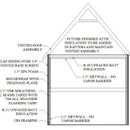Attic floor insulation and vapor barrier with phased construction
I’m looking for help on an attic floor assembly. This is new construction where the attic will not be finished right away. It could remain unfinished for 5 years. I want to install the insulation and vapor barrier to perform correctly for both an unfished and finshed attic detail. I want to make sure the assembly is drying to the correct side.
I have attached a pdf to show the assembly.
I think the main question comes down to this: Should I install a vapor barrier on the underside of the attic floor with unfaced batt insulation? Will this cause any issues once I condition the attic and insulate the rafter cavity and install a new vapor barrier on the underside of the rafters?
I am not currently planning on using a vapor barrier on the walls so that it can dry to the inside with my use of exterior rigid EPS foam.
Thank you,
Seth
GBA Detail Library
A collection of one thousand construction details organized by climate and house part











Replies
Seth,
1. You don't need an interior vapor barrier on a ceiling. All you need is a vapor retarder. Vapor retarder paint will work. So don't install any polyethylene. For more information on this issue, see these two articles:
Do I Need a Vapor Retarder?
Vapor Retarders and Vapor Barriers
2. It's much more important to pay attention to airtightness than to worry about vapor diffusion.
3. Why not just install the insulation along the sloped roof plane? Even if your attic is unfinished, you can still install the insulation along the sloped roof plane. I think that would make more sense the insulating twice, in two different locations.
Thank you,
I agree with the logic behind your comment #3. That's what I've been wrestling with. My reasoning for not insulating the sloped roof right away is that I don't want to have to finish the room right away. Let me know If I'm misinterpreting the code here. My understanding is that I can't leave the insulation exposed and that it would require a thermal barrier "1/2" drywall". If I do this, I essentially have a finished room.
Seth,
To the best of my knowledge, you can't leave spray foam exposed. Nor can you leave rigid foam exposed. Nor can you leave kraft facing exposed.
But you are allowed to leave fiberglass batts exposed, and you are allowed to leave mineral wool batts exposed. These can be pinned in place with steel wires that span the rafters.
The roof assembly won't perform as well as it would if there were an interior air barrier, but the assembly would be legal.